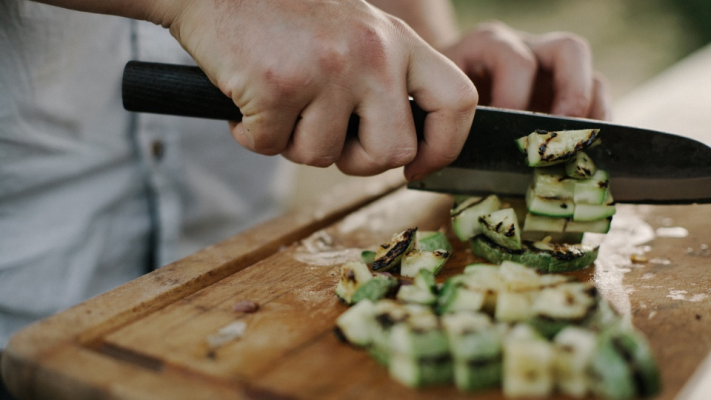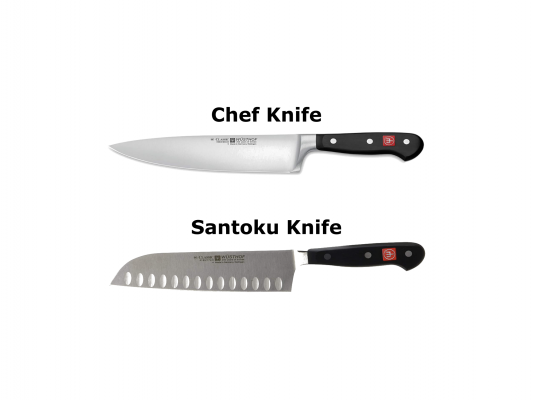Japan
Compare Santoku Knife Vs Chef Knife
Are you in a dilemma in choosing between a Santoku Knife and a Chef knife for your kitchen needs? If this is your case, then you are in the right place and you only need to stay composed reading this article and within a short while you will have made your choice so easily and without any worries!

>> You may also like:
- Best Santoku Knife – Japanese Santoku Knife Reviews
- Difference between Japanese Nakiri Vs Santoku Knife
- Difference between Japanese Kiritsuke vs Santoku Knife
- What is the difference between a Santoku and Gyuto Knife?
If you are not much exposed to a Santoku knife and a Chef knife, you will find them to be looking so similar. Even though these two knives might look much alike, there are tons and tons of differences between them. Understanding these differences will let you make the correct choice of choosing one that will perfectly meet your needs.
With much said, let’s dive in and see which of the knives you will vouch for!
The Major Differences between a Santoku knife and a Chef’s knife
Without rushing to the differences, there is a need to first understand the similarities of these two knives. The first similarity is that both of these knives are intended for a general purpose which involves cutting and chopping tasks, slicing, dicing and mincing. From the listed purposes, the two knives are commonly used in both professional and home kitchens.
All these two knives are made of assortment materials which are not limited to ceramic and even metal. Those knives that are made of steel are always preferred for professional use since they last longer and are corrosion resistance. A major difference that you need to know of here is that the Japanese blades such as the Santoku in our case are always thinner and also harder thus enabling chefs to practice accurate tasks.
Santoku Knife Features
Some of the features of the Santoku Knife are not limited to:
- Basically from Japan
- Larger sheepsfoot blade that lacks a tip
- Thinner blade as compared to that of a Chef’s knife to allow more accurate slicing
- It can be a single handed or a double bevel
- It lacks a bolster
- Has a balanced weight
- Its lighter to hold
- May come with a granton edge usually with small divots or scallops on the blade that prevents food from sticking on it.
- Comes in several sizes such as 5” to 7.9”
Chef’s Knife Features
- Heavier when holding
- From either Germany or France
- Has a bolster
- Has a wide blade that curves towards the tip
- Designed in serrated varieties
- Might have a granton edge
- Comes in several sizes such as 6” to 12”
- Mainly in a double bevel
Comparing the Blade Shape of Santoku Knife vs. Chef’s Knife in Slicing, Dicing and Cutting
What can you tell about the blades of these two knives? If you have nothing to say, here are some of the things you need to know about the blades of these two rivals.
A chef’s knife is commonly known for a blade tip that allows the chef to gently move the knife forward to complete the cutting process. Unlike the Santoku knife that lacks the tip thus makes one to slice in one direction downwards to cut. Here, the Santoku knife takes an early lead since it makes cutting faster and more efficient.
Another area where you might notice a difference is on the bevel. Many Santoku knives that are always used by professional chefs are ever single bevel. Again, when sharpening a Santoku knife, one can opt to a smaller angle that results in a sharper blade. This is opposed in the chef’s knife where one can only sharpen it at 30 degrees. For this, you will notice that a Santoku knife will be sharper than the chef’s knife hence preferred whenever you cut thin slices.

Best tasks for a Santoku Knife
Well, there are three activities where you need to use the Santoku knife for the best results. These three uses are dicing, mincing and even chopping. These can be chopping large meat bones, where accuracy is needed such as peeling or even slicing bread. A Santoku knife will offer thin slices of food whenever you need them.
Some of these tasks are:
- Mincing herbs
- Slicing cheese
- Chopping meat
- Slicing, chopping and dicing nuts, vegetables and fruits
- Scooping food from a cutting board due to its wide blade
Best tasks for a Chef’s Knife
Why do you have to choose the Chef’s knife? A chef’s knife is known for its versatility in most of the professional kitchens. With a Chef’s knife you can almost do all the tasks except chopping meat bones, peeling fruits and even chopping frozen foods. You can also try a serrated one whenever you want to slice bread.
Where you need to use a Chef’s knife:
- Slicing of cheese
- Dicing, chopping and slicing nuts, vegetables and fruits
- Complicated or even versatile cutting
You need to know that the Chef’s knife is slightly preferred when slicing, thus you need to opt for a Santoku knife when your main goal is to slice.
Comparing the Sharpening process and Caring of a Santoku Knife vs. A Chef’s Knife
With the correct care, cleaning, sharpening and storing knives, they should be able to last for a very long time. For both of the two knives, one is required to hand wash and dry using a soft and clean towel. You should refrain from using the dishwashers and even the scourers and choose to use the wooden box or even block for washing and storing these knives.
Well, the difference in these two knives lies in the sharpening process and which of the two knives turns out to be easy to sharpen and again which one becomes sharper than the other. Well, for a Santoku knife, you’ll need a whetstone to sharpen. Sharpening a Santoku knife is also easier to sharpen because they lack a bolster. A Santoku knife can also be sharpened at 10 – 15 degrees that makes it sharper than a Chef’s knife that can be sharpened at about 15 – 20 degrees.
The Verdict
After comparing both the Santoku knife and the Chef’s knife in multiple areas, it’s evident that a Santoku knife is more likely to ease your kitchen tasks as compared to the Chef’s knife. However, clearly read the comparisons and choose one that will perfectly meet your kitchen needs. Good luck!
